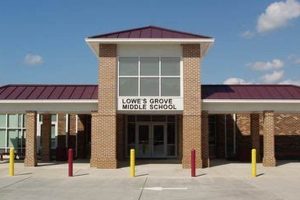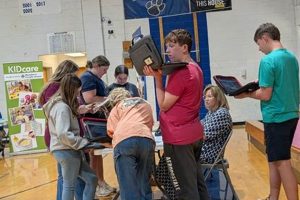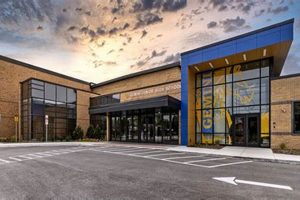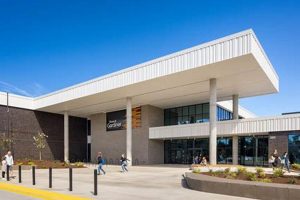Adapting the middle school curriculum, particularly within the humanities, to meet the diverse learning needs of students with disabilities is crucial for fostering inclusive classrooms. This involves modifying instructional materials, teaching strategies, and assessment methods to ensure all students can access and engage with the subject matter. For example, providing visual aids, hands-on activities, and differentiated assignments allows students with varying learning styles and abilities to grasp complex concepts and develop essential skills. This might involve adapting primary source analysis for a student with a visual impairment through the use of tactile materials or auditory recordings, or adjusting the pacing and complexity of research projects for students with cognitive processing challenges.
Inclusive education benefits all students by creating a supportive and empathetic learning environment. When educators prioritize accessibility and differentiated instruction, they foster a sense of belonging and empower students with disabilities to reach their full potential. Historically, students with disabilities were often excluded from mainstream classrooms. The shift towards inclusive education reflects a growing understanding of the importance of providing equitable learning opportunities for all. This movement emphasizes the need for individualized support and accommodations to ensure that every student can thrive academically and socially. The benefits extend beyond individual students to enrich the classroom community as a whole, fostering empathy, understanding, and collaboration among peers.
This discussion will further explore the practical applications of inclusive pedagogy within the social studies curriculum, addressing specific strategies and resources for supporting students with various disabilities. It will also examine the legal and ethical frameworks that underpin inclusive education, highlighting the rights of students with disabilities to access a quality education. Finally, it will consider the ongoing challenges and future directions in the field, emphasizing the importance of continued research and professional development to ensure that all students have the opportunity to succeed.
Tips for Inclusive Social Studies Instruction in Middle School
Educators play a vital role in fostering inclusive classrooms where students with diverse learning needs can thrive. The following tips provide practical guidance for adapting social studies instruction to support middle school students with disabilities.
Tip 1: Universal Design for Learning (UDL): Implement UDL principles by offering multiple means of representation, action and expression, and engagement. For instance, provide content through text, audio, and video formats. Allow students to demonstrate understanding through various methods like presentations, written assignments, or interactive projects. Offer choices in activities to cater to individual interests and learning styles.
Tip 2: Differentiated Instruction: Tailor instruction and assessment to individual student needs. This includes adjusting the complexity of tasks, providing varied levels of support, and offering flexible timelines for completion. A research project could be differentiated by providing scaffolding questions for some students while encouraging others to pursue independent inquiry.
Tip 3: Assistive Technology: Integrate assistive technology tools to enhance learning accessibility. Text-to-speech software, graphic organizers, and voice recognition programs can empower students with varying disabilities to access and process information effectively.
Tip 4: Collaborative Learning: Encourage peer interaction and collaboration through group activities and projects. This allows students to learn from each other and develop social skills. Structured group work with clearly defined roles can ensure meaningful participation for all students.
Tip 5: Multi-Sensory Activities: Engage students through hands-on activities and simulations that incorporate visual, auditory, and kinesthetic elements. Using historical artifacts, creating timelines, and role-playing historical events can make learning more engaging and memorable.
Tip 6: Accessible Materials: Ensure all learning materials are accessible to students with disabilities. This includes providing materials in alternative formats, such as large print, braille, or digital text. Captions and transcripts should be provided for videos and audio recordings.
Tip 7: Ongoing Assessment and Feedback: Regularly assess student understanding through formative and summative assessments. Provide specific and constructive feedback that focuses on individual progress and strengths. Use diverse assessment methods, including portfolios, presentations, and self-reflection.
By implementing these strategies, educators can create inclusive social studies classrooms where all students can actively participate, learn, and grow. These practices not only benefit students with disabilities but also enrich the learning experience for all students.
This exploration of inclusive practices in social studies education concludes with a discussion of future directions and the ongoing need for professional development to refine and enhance inclusive pedagogy.
1. Individualized Education Programs (IEPs)
Individualized Education Programs (IEPs) are crucial for ensuring that middle school students with special needs receive appropriate support and accommodations in social studies. IEPs provide a framework for tailoring instruction and assessment to meet the unique learning needs of each student. They outline specific goals, accommodations, and modifications designed to address individual strengths and challenges. This individualized approach is essential for fostering success in social studies, a subject that often involves complex concepts, diverse learning activities, and varied assessment methods. For example, a student with a learning disability in reading comprehension might have IEP goals related to accessing and understanding social studies texts, with accommodations such as text-to-speech software or graphic organizers. A student with ADHD might have IEP goals focused on improving attention and organizational skills, with accommodations such as preferential seating or frequent breaks.
The IEP process involves collaboration among teachers, parents, administrators, and related service providers, ensuring a holistic approach to supporting the student’s learning. The IEP team considers the student’s present levels of performance, learning styles, and individual needs when developing the IEP. In social studies, this might involve adapting primary source materials, modifying assignments, or providing alternative assessment options. For instance, a student with a visual impairment might benefit from tactile maps or audio descriptions of historical images. A student with a writing disability might be allowed to present research findings orally rather than through a written report. The IEP serves as a dynamic document, regularly reviewed and updated to reflect the student’s progress and evolving needs. This ensures that the support and accommodations provided remain relevant and effective throughout the student’s middle school experience.
Effective implementation of IEPs in social studies contributes significantly to student success and fosters inclusive learning environments. When educators adhere to the IEP’s provisions, they demonstrate a commitment to providing equitable access to the curriculum for all students. This, in turn, promotes student engagement, self-advocacy, and academic growth. Challenges can arise in effectively implementing IEPs, such as limited resources or inadequate training for educators. However, ongoing professional development and collaborative problem-solving within the IEP team can help address these challenges and ensure that all students have the opportunity to thrive in social studies and beyond.
2. Differentiated Instruction
Differentiated instruction is essential for meeting the diverse learning needs of middle school students with special needs in social studies. It recognizes that students learn at different paces, through different modalities, and with varying levels of prior knowledge. By offering multiple pathways to access content, process information, and demonstrate understanding, differentiated instruction creates a more equitable and engaging learning environment. Consider a social studies unit on ancient civilizations. A teacher might differentiate content by providing texts at varying reading levels, offering visual aids like timelines and maps, or incorporating audio recordings. Process differentiation could involve providing graphic organizers, offering guided notes, or allowing students to choose between individual and group research projects. Product differentiation might include allowing students to present their learning through oral presentations, written reports, or multimedia projects. This flexibility ensures all students can engage meaningfully with the curriculum.
The impact of differentiated instruction on student learning is significant. When students are presented with learning experiences that align with their strengths and needs, their motivation and engagement increase. This, in turn, leads to improved academic outcomes. For instance, a student with dyslexia might struggle with traditional textbook readings but excel in a project-based learning environment where they can demonstrate their understanding through visual presentations or hands-on activities. A student with ADHD might benefit from frequent movement breaks and opportunities for kinesthetic learning during social studies lessons. Differentiated instruction also fosters a more inclusive classroom culture by recognizing and valuing the unique contributions of each learner. It allows students to develop a sense of ownership over their learning and build confidence in their abilities. Providing various learning resources, such as audiobooks, videos, and interactive simulations, caters to different learning preferences and ensures equitable access to information.
Implementing differentiated instruction requires careful planning and ongoing assessment. Teachers must be attuned to their students’ individual learning profiles and adjust their instructional strategies accordingly. Collaboration with special education staff, related service providers, and parents is crucial for developing effective differentiated instruction plans. While differentiated instruction can be time-consuming and require additional resources, the benefits for students with special needs are undeniable. It is a key component of inclusive education, ensuring that all students have access to a high-quality social studies education and the opportunity to reach their full potential. The continued development of adaptable resources and teaching strategies will further enhance differentiated instruction within social studies education, fostering a more inclusive and equitable learning environment for all students.
3. Assistive Technologies
Assistive technologies play a crucial role in facilitating access to social studies curriculum for middle school students with special needs. These technologies bridge the gap between learning challenges and academic content, promoting greater independence and engagement in the learning process. Specific examples include text-to-speech software, which converts written text into audio, enabling students with reading difficulties to access social studies texts independently. Graphic organizers and mind-mapping tools support students with organizational and cognitive challenges in structuring information and understanding complex concepts. Furthermore, speech-to-text software allows students with writing difficulties to express their understanding and complete written assignments. For example, a student with dyslexia can use text-to-speech software to listen to historical accounts, while a student with dysgraphia can use speech-to-text software to compose essays on historical events.
The impact of assistive technologies extends beyond mere access to information. These tools empower students to actively participate in classroom discussions, conduct research, and demonstrate their learning in ways that were previously inaccessible. For students with visual impairments, screen readers and braille displays open doors to digital resources and research materials. Students with physical disabilities can utilize adaptive keyboards and mice to navigate online learning platforms and engage with interactive social studies simulations. The use of assistive technologies fosters a more inclusive learning environment where students with diverse learning needs can participate fully and contribute meaningfully to classroom activities. This not only enhances individual student learning but also enriches the overall learning experience for all students by fostering collaboration and understanding.
Integrating assistive technologies effectively requires careful consideration of individual student needs, appropriate device selection, and ongoing training and support. Collaboration between educators, assistive technology specialists, and parents is essential to ensure that chosen technologies align with student IEPs and are implemented effectively within the classroom. While challenges such as funding and access to training can hinder implementation, the potential benefits of assistive technologies in promoting inclusive education in social studies are undeniable. Continued advancements in technology and increased awareness of their transformative potential promise even greater opportunities for students with special needs to access and excel in social studies and beyond. Addressing these challenges through adequate funding, professional development, and ongoing technical support is essential to maximizing the impact of assistive technologies in fostering inclusive education.
4. Universal Design for Learning
Universal Design for Learning (UDL) provides a framework for creating flexible and accessible learning environments that cater to the diverse needs of all learners, including middle school students with special needs in social studies. UDL’s three core principlesmultiple means of representation, action and expression, and engagementalign directly with the goals of inclusive education by offering varied pathways to access content, demonstrate understanding, and participate actively in the learning process. This framework recognizes that learners differ in how they perceive and comprehend information, how they interact with learning materials, and what motivates and engages them. In social studies, UDL principles can be applied to create lessons that offer diverse learning experiences. For instance, providing historical information through text, audio recordings, and videos offers multiple means of representation. Allowing students to demonstrate their understanding through written reports, oral presentations, or multimedia projects offers multiple means of action and expression. Incorporating interactive simulations, debates, and project-based learning activities offers multiple means of engagement. By offering choices and flexibility, UDL allows educators to create a learning environment that caters to the strengths and needs of each student.
The practical application of UDL in middle school social studies classrooms yields numerous benefits for students with special needs. Students with learning disabilities in reading can access complex historical texts through audio recordings or simplified versions. Students with attention challenges benefit from structured lessons with clear expectations and opportunities for movement and interaction. Students with communication difficulties can express their understanding through visual aids or assistive technologies. A real-life example could be a lesson on the American Revolution. A teacher employing UDL principles might offer students the choice of reading a textbook chapter, listening to an audiobook, or watching a documentary about the events. Students could then demonstrate their understanding by creating a timeline, writing an essay, participating in a debate, or developing a multimedia presentation. This flexibility ensures that all students, regardless of their learning differences, can access and engage with the curriculum meaningfully.
UDL’s emphasis on flexibility and accessibility is particularly relevant in the context of inclusive social studies education. It acknowledges that disability is not solely an individual characteristic but rather a product of the interaction between individual differences and the learning environment. By proactively designing learning experiences that are accessible from the outset, educators minimize the need for retroactive accommodations and modifications. This proactive approach not only benefits students with identified disabilities but also creates a more welcoming and supportive learning environment for all students. However, implementing UDL effectively requires ongoing professional development, access to appropriate resources and technologies, and a commitment to inclusive pedagogical practices. Addressing these challenges is crucial to realizing the full potential of UDL in creating equitable and engaging social studies learning experiences for all middle school students. The ongoing development of accessible educational resources and teacher training programs focused on UDL principles will further enhance inclusive practices within social studies education and contribute to a more equitable learning experience for all.
5. Inclusive Classroom Environment
An inclusive classroom environment is paramount for middle school students with special needs in social studies. It fosters a sense of belonging, promotes active participation, and ensures equitable access to the curriculum. This environment considers the diverse learning styles, needs, and strengths of all students, creating a supportive and welcoming space where every learner can thrive. Creating such an environment involves careful consideration of various facets, including physical space, instructional strategies, social-emotional learning, and collaboration.
- Physical Space
The physical layout of the classroom plays a significant role in fostering inclusivity. Flexible seating arrangements allow for individual and group work, accommodating students with varying physical and sensory needs. Designated quiet areas provide students with opportunities for focused work or sensory breaks, reducing distractions and promoting self-regulation. Accessible learning materials, including large-print texts, tactile maps, and assistive technologies, ensure equitable access to information for all students. For instance, a classroom with clearly defined learning zones, flexible seating options, and readily available assistive technologies creates a welcoming and supportive environment for students with diverse needs.
- Instructional Strategies
Differentiated instruction is a cornerstone of inclusive classrooms. Providing varied instructional materials, activities, and assessments caters to diverse learning styles and allows students to demonstrate their understanding in multiple ways. Incorporating Universal Design for Learning (UDL) principles ensures that information is presented in multiple formats, students are given choices in how they engage with content, and multiple means of demonstrating understanding are offered. For example, a social studies teacher might offer students the choice of completing a research project individually, collaborating with a partner, or creating a multimedia presentation to showcase their learning. This flexibility allows all students to access and engage with the curriculum in a way that aligns with their individual strengths and learning preferences.
- Social-Emotional Learning
An inclusive classroom environment prioritizes social-emotional learning (SEL) by promoting empathy, respect, and understanding among students. Explicitly teaching social skills, fostering positive peer relationships, and creating opportunities for collaborative learning contributes to a supportive and inclusive classroom culture. For example, incorporating class meetings, peer mediation programs, and collaborative projects can help students develop essential social skills, build positive relationships with their classmates, and create a sense of community within the classroom. This, in turn, supports the academic and social-emotional well-being of students with special needs.
- Collaboration and Communication
Effective collaboration and communication among teachers, special education staff, parents, and students are essential for creating and maintaining an inclusive classroom environment. Regular communication ensures that everyone is informed about student progress, challenges, and successes. Collaborative planning and problem-solving helps to address individual student needs effectively and create a cohesive learning experience. For instance, regular communication between the general education teacher, special education teacher, and parents can ensure that a student’s IEP goals are being addressed effectively in the social studies classroom. This collaborative approach fosters a sense of shared responsibility and ensures that the student receives consistent and appropriate support. Parent-teacher conferences, student-led IEP meetings, and ongoing communication through digital platforms can facilitate information sharing and collaborative decision-making.
These interconnected facets contribute to a supportive and empowering learning environment where middle school students with special needs can access the social studies curriculum, engage meaningfully with content, and develop their full potential. An inclusive classroom benefits all students by fostering empathy, respect, and a deeper understanding of diversity, preparing them for success in a diverse and interconnected world. The ongoing development of inclusive practices and resources is essential to ensuring that all students have the opportunity to thrive academically, socially, and emotionally within the social studies classroom and beyond.
Frequently Asked Questions
This section addresses common questions regarding the inclusion of middle school students with special needs in social studies classrooms.
Question 1: How can social studies teachers effectively differentiate instruction for students with varying learning needs?
Differentiated instruction involves adapting teaching methods, materials, and assessments to meet individual student needs. This may include providing varied reading materials at different complexity levels, using visual aids and graphic organizers, offering choices in assignments, and adjusting pacing. Collaboration with special education staff is crucial for developing and implementing effective differentiation strategies.
Question 2: What role do Individualized Education Programs (IEPs) play in social studies instruction?
IEPs outline specific learning goals, accommodations, and modifications for students with disabilities. Social studies teachers must be familiar with and adhere to each student’s IEP to ensure appropriate support and equitable access to the curriculum. This includes providing required accommodations, such as extended time on tests or alternative assignments, and regularly monitoring student progress toward IEP goals.
Question 3: How can assistive technologies support students with special needs in social studies?
Assistive technologies, such as text-to-speech software, graphic organizers, and speech-to-text programs, can greatly enhance access to social studies content for students with disabilities. These tools can help students overcome challenges with reading, writing, organization, and communication, enabling them to participate more fully in classroom activities and demonstrate their learning effectively. Selection and implementation of assistive technologies should be based on individual student needs and IEP goals.
Question 4: What strategies can create a more inclusive social studies classroom environment?
An inclusive classroom environment fosters a sense of belonging and encourages active participation for all students. This can be achieved through flexible seating arrangements, designated quiet areas, readily available learning materials in accessible formats, and a classroom culture that values diversity and respect. Explicitly teaching social skills and fostering positive peer relationships further enhances inclusivity.
Question 5: How can parents and families support the inclusion of their children with special needs in social studies?
Open communication and collaboration between parents, teachers, and special education staff are essential. Parents can provide valuable insights into their child’s learning styles, strengths, and challenges. Active participation in IEP meetings and ongoing communication with the school can help ensure that the student’s needs are being met effectively. Parents can also support learning at home by providing access to resources and creating a supportive learning environment.
Question 6: What resources are available for social studies teachers seeking to enhance their inclusive practices?
Numerous resources are available, including professional development workshops, online communities of practice, and publications focusing on inclusive pedagogy and differentiated instruction. Collaboration with special education colleagues and assistive technology specialists can also provide valuable support and guidance. Organizations such as the National Council for the Social Studies (NCSS) offer resources and professional development opportunities specifically focused on social studies instruction.
Addressing these common questions and concerns proactively contributes to creating a more informed and supportive approach to inclusive social studies education, benefiting all learners.
This FAQ section concludes the discussion on inclusive practices in social studies education for middle school students with special needs. The information presented underscores the importance of individualized support, differentiated instruction, assistive technologies, universal design for learning, and inclusive classroom environments in fostering equitable access and meaningful learning experiences for all students.
Conclusion
Successfully integrating students with special needs into the middle school social studies curriculum requires a multifaceted approach. This exploration has highlighted the crucial role of individualized education programs (IEPs), differentiated instruction, assistive technologies, universal design for learning (UDL), and inclusive classroom environments in fostering equitable access and meaningful learning experiences. Effective implementation hinges on collaboration among educators, specialized support staff, parents, and students themselves. By understanding individual learning needs and tailoring instruction accordingly, educators can empower all students to engage with social studies content, develop critical thinking skills, and become informed and engaged citizens.
Continued progress in inclusive education necessitates ongoing professional development for educators, increased access to appropriate resources and technologies, and a sustained commitment to fostering inclusive school cultures. The ultimate goal remains to create learning environments where every student, regardless of individual learning differences, can thrive academically, socially, and emotionally. The future of social studies education depends on embracing inclusive practices, ensuring that all students have the opportunity to develop a deep understanding of the world around them and their place within it.







